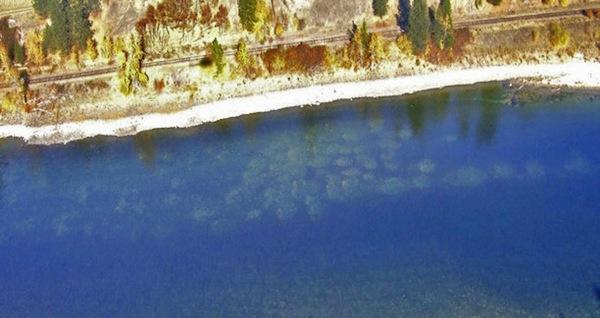forum
library
tutorial
contact

NOAA Fisheries: Snake River Salmon
that Spawn in Idaho Still Imperiled
by Rocky Barker
Idaho Statesman, May 26, 2016
|
the film forum library tutorial contact |

|
NOAA Fisheries: Snake River Salmon
by Rocky Barker
|
Federal fisheries managers deny petition to remove fall chinook from threatened species list.
 Federal fisheries managers denied a petition Thursday to delist the Snake River fall chinook, keeping the sea-running salmon that spawn in Idaho rivers listed as threatened.
Federal fisheries managers denied a petition Thursday to delist the Snake River fall chinook, keeping the sea-running salmon that spawn in Idaho rivers listed as threatened.
NOAA Fisheries published the decision in the Federal Register along with a five-year status review for three other listed species in the Snake River watershed.
"Based on the best scientific and commercial data available, we have determined that delisting of the Snake River fall-run chinook (evolutionarily significant unit) is not warranted at this time," the agency responded. "We conclude that the Snake River fall-run chinook is likely to become an endangered species within the foreseeable future throughout all or a significant portion of its range, and will remain listed as a threatened species under the (Endangered Species Act)."
The Chinook Futures Coalition, which represents current and retired Alaska fishermen, filed the delisting petition in 2015 for the fall chinook that spawn in the Snake River below Hells Canyon Dam and from the Tucannon River, Grande Ronde River, Imnaha River, Salmon River and Clearwater River and the rivers' sub-basins, as well as four hatcheries.
The group said recent returns of fall chinook meet the recovery goals and that NOAA Fisheries should consider the returning hatchery fish in its counts toward a recovering population. The Alaska group cares because the fall chinook swim through Alaskan waters and lower the allowable catch quota.
"While the coalition is still reviewing the decision, the coalition disagrees with several aspects of the agency's analysis and believes that the best available science supports a decision to delist the species," said Ashley J. Remillard, an attorney who represents the Alaska commercial and recreational fishermen.
NOAA Fisheries also kept the current listings in place for Snake River sockeye (listed as endangered), Snake River spring-summer chinook (threatened) and Snake River steelhead (threatened). NOAA is required to review the status of listed species every five years.
In 2015 NOAA released a proposed recovery plan for Snake River fall chinook salmon, describing the fish as the only stock of Snake River salmon that biologists say may be able to recover without major improvements in the migration corridor through eight dams on the Snake and Columbia rivers. The fish were nearly sent into extinction by the building of the Hells Canyon Complex of dams by Idaho Power in the 1950s and '60s, which closed off 80 to 85 percent of the streams that made up its spawning habitat.
The chinook has come a long way in less than 25 years.
The effort involved Idaho Power, the Nez Perce, state and federal fisheries officials, and the Bonneville Power Administration. Nez Perce fisheries officials planted hatchery Snake River fall chinook in many tributaries and increased the number of fish. Idaho Power stabilized flows below its dams in the fall and the spring to help spawning.
The 75,846 native and hatchery-born fall chinook counted at Lower Granite Dam in 2013 returned to just 15 percent of their historic habitat and represent unsustainable gains, NOAA Fisheries officials said.
"Achieving low risk for spatial structure/diversity for the Snake River fall-run Chinook ESU would either require re-establishing the extirpated population above Hells Canyon Dam, or that one or more major spawning areas in the Lower Mainstem Snake River population produce a significant level of natural-origin spawners with low influence from hatchery-origin spawners relative to the other major spawning areas," it said in the Federal Register.
Once, more than a half-million fall chinook returned to the Snake River and its tributaries all the way into Nevada. But more than a century of farming, mining and other development, and the cutoff of its habitat by dams, almost made them extinct.
Just 78 wild fall chinook returned to Lower Granite Dam on the Snake in 1990. In 2013, biologists counted 20,222 wild fall chinook.
Fall chinook are adapting to their very altered environment and a changing climate. Usually, fall chinook hatch in the spring. The smolts, just inches long, enter the ocean a few months later. But as many as a fourth of these chinook are staying put in the river for at least a year -- either at the mouth of the Clearwater River or farther downstream in the Columbia -- before heading to sea.
The chinook that delay their migration are about eight times more likely to make it back to their spawning grounds as adults than the traditional migrating fall chinook.
Related Pages:
Columbia System Gets Hotter and Deadly for Salmon and Steelhead by Rocky Barker, Idaho Statesman, 7/30/13
The Heat Is On For Salmon by Rocky Barker, Idaho Statesman, 8/3/13
learn more on topics covered in the film
see the video
read the script
learn the songs
discussion forum
